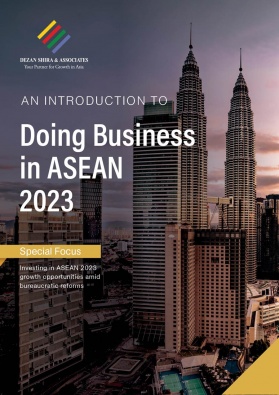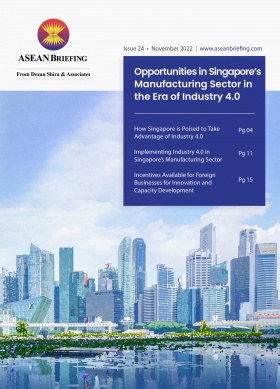ASEAN Economic Outlook 2023
The ASEAN region will remain one of the fastest-growing regions of the world in 2023 but economic growth will likely fall marginally from 2022. This is largely due to worsening global economic conditions and tightening monetary policy.
The second half of the year will likely see conditions that are more conducive to organic growth as falling inflation provides central banks with greater rate flexibility. This should complement increasing economic activity in China.
The ASEAN region will remain attractive to foreign direct investment, with trends in commercial and state investment likely to remain consistent throughout the year, despite a more challenging macroeconomic environment.
The ASEAN (the Association of Southeast Asian Nations) region was among the fastest growing regions of the world in 2022 – the Asian Development Bank (ADB) predicted that economic growth in Southeast Asia will equate to 5.5 percent for 2022.
However, we enter 2023 with a host of evolving economic pressures. Some of which will undoubtedly act as a drag on growth globally. As such, the ADB recently revised its 2023 forecast to 4.7 percent for ASEAN as global demand weakens.
It is worth noting that forecasts do vary, and this can be partially dependent on how organizations categorize the region. Credit Suisse analysts expect the growth of the ASEAN-six economies – Indonesia, Malaysia, the Philippines, Singapore, Thailand, and Vietnam – to moderate to 4.4 percent in 2023 from a projected 5.6 percent in 2022.
These figures put regional economic growth some way above the global average. The IMF has forecast global growth at 3.2 percent in 2022 and 2.7 percent in 2023. As such, ASEAN remains an attractive destination for international investment, providing investors with exposure to one of the fastest-growing regions globally.
The ASEAN growth story
ASEAN nations could benefit from a privileged geopolitical position in future years as the US-China rivalry intensifies and both superpowers seek to deepen ties in the region. Both nations have highlighted their commitment to trade with ASEAN economies – China particularly through access to the Regional Comprehensive Economic Partnership (RCEP) agreement and the Comprehensive and Progressive Agreement for Trans-Pacific Partnership (CPTPP). The US only has free trade agreements with selected ASEAN countries.
This superpower rivalry is not the only factor that could positively contribute to ASEAN growth in 2023. Several nations in the region have large international tourism sectors, and a further improving epidemiological environment should contribute to the industry’s recovery in 2023.
According to Goldman Sachs, Thailand and Malaysia could post decent four percent growth next year on normalizing global tourism and travel. The former’s current account should rebalance next year on a tourism rebound.
|
Nation |
Goldman Sachs real GDP estimates (percent), 2023 |
Consensus real GDP estimates (percent), 2023 |
|
Singapore |
1.5 |
2.6 |
|
Malaysia |
4 |
4.3 |
|
Thailand |
4 |
3.9 |
|
Indonesia |
4.4 |
4.9 |
|
Philippines |
5.8 |
5.7 |
|
Vietnam |
5.8 |
6.5 |
Malaysia, the Philippines, and Thailand will likely see the tourism sector recover to pre-pandemic levels in 2023. But doubts remain as to whether Chinese tourists will return immediately despite a recent removal of restrictions. In December, the Chinese immigration authority said it would resume issuing visas for mainland residents to travel overseas from January 8.
S&P Global analysts suggest that the global slowdown will have less impact on domestic demand-led economies such as Indonesia and the Philippines – both countries, the organization predicts, will see at least five percent growth in 2023. The US-based corporation contends that domestic demand has further to recover in Indonesia, Malaysia, the Philippines, and Thailand, as these nations reopen in their entirety following the pandemic.
However, all of the above is secondary to the aforementioned prevailing economic conditions. Weakening growth, and even recessions, in developed economies, will reduce economic activity in demand in ASEAN nations. Meanwhile, many Southeast Asian central banks have raised policy rates in response to rising global interest rates, capital outflows, currency depreciation, and accelerating inflation with higher global food and energy prices. As noted, falling inflation should allow central banks to adopt a more dovish approach towards the second half of the year.
Foreign direct investment
ASEAN economies have been attractive destinations for FDI in recent years. These nations generally provide attractive alternatives for companies looking to reduce their exposure to China in light of increasing trade barriers and the desire to simply find cheaper production sites.
Nations in the region are broadly seeing faster than average GDP growth, reflecting booming population expansion and increasingly liberal trade policies. In turn, multinational corporations are increasingly looking to Southeast Asia as an alternative production hub, attracted by its competitive wages, improving business regulations and infrastructure, and increasing domestic demand.
Singapore saw some US$100 billion in foreign investment in 2021. Key industries for investment in Singapore include IT, aerospace, electronics, pharmaceuticals, and professional services.
Indonesia saw some US$43 billion in foreign investment in 2022, the highest in the country’s history. For 2023, the government aims to increase its foreign and domestic investment target to US$92 billion, or 1,400 trillion rupiah.
Indonesia is the only G20 member in ASEAN, and with its abundance of natural resources and large domestic market of 260 million, the country offers long-term investment opportunities.
Vietnam offers investors access to a host of internationally competitive industries and provides greater market access, and certainty for producers, than China. Amid a trade war between the US and China, Vietnam has emerged as an alternative supplier of wood products. The US is already the main destination market for the exports of wood products. Similarly, Vietnam’s textile industry appears increasingly attractive following laws passed in the US concerning forced labor and cotton sourced from China’s Xinjiang.
Meanwhile, Thailand has been a consistent recipient of Chinese investment for some time. The nation is at the heart of the ASEAN bloc and is integral to Chinese state plans for global connectivity as well as private investment. The former point is being addressed by the Belt and Road Initiative while private investors are increasingly seeing Thailand as an investment destination for initiatives in crypto, fintech, blockchain, and AI, as well as health care and medical tourism.
The above examples are reflective of longer-term trends that will continue despite a weakening global economy. The continuing increase of FDI into ASEAN, particularly for Singapore, Malaysia, Thailand, Indonesia, and Vietnam will likely continue in 2023.
China reopening in focus
China and the health of its economy is, partially by virtue of its geographic proximity and the associated trade networks, a considerable factor influencing economic growth in the ASEAN region.
The impact of China’s sudden reopening is likely to be twofold. In the first quarter of 2023, Covid, as well as other viruses that had been suppressed by restrictions, will likely amplify supply-chain bottlenecks and waning demand issues.
However, following a challenging epidemiological period, China is expected to experience the reopening boom cycle already experienced by most other nations in the wake of Covid-19. The World Bank data sees Chinese economic growth recovering to 4.3 percent in 2023 from an estimated 2.7 percent in 2022.
The reopening is likely to have a profound impact on headline economic data despite risk factors including persistent stress in the real estate sector.
While some sectors in some ASEAN economies can be seen as net beneficiaries of China’s internal challenges and its trade war with the US, improving Chinese growth is positive for the ASEAN region.
Webinar – Future-Proof Your Business: De-Risking Your Supply Chain in Asia
August 23, 2023 | 9:00 AM PDT / 12:00 PM EDT
In this webinar, a panel of Business Intelligence Leaders will help you understand key differences between the main markets in South / Southeast Asia and discuss their evolving supply chain ecosystems, enabling you to make informed decisions to de-risk your supply chain.
About Us
ASEAN Briefing is produced by Dezan Shira & Associates. The firm assists foreign investors throughout Asia and maintains offices throughout ASEAN, including in Singapore, Hanoi, Ho Chi Minh City, and Da Nang in Vietnam, Munich, and Esen in Germany, Boston, and Salt Lake City in the United States, Milan, Conegliano, and Udine in Italy, in addition to Jakarta, and Batam in Indonesia. We also have partner firms in Malaysia, Bangladesh, the Philippines, and Thailand as well as our practices in China and India. Please contact us at asia@dezshira.com or visit our website at www.dezshira.com.







